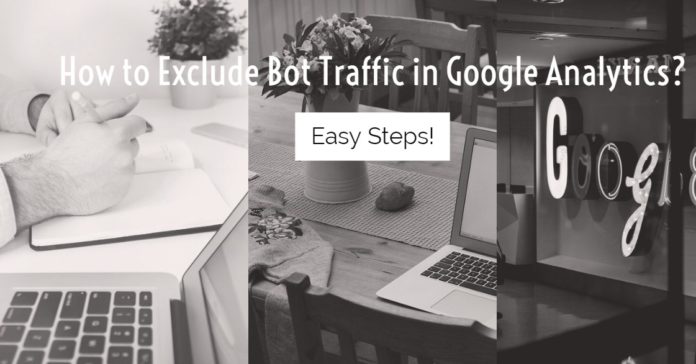If you are into blogging or a website owner, you must be using Google Analytics as a tool for searching the traffic that you may be getting. The site traffic is what would play a significant role in improving the performance of your website. In fact, it should be one of the best options to check market trends and behavioral shifts of your audience. But, it remains the fact that even a powerful tool like Google Analytics is not free from bot traffic. How would you be able to detect, segregate and exclude bot traffic in Google Analytics? That is precisely what we would be learning in today’s post.
Exclude Bot Traffic in Google Analytics
Google Analytics is undoubtedly the best tool to analyze and understand the traffic on your site. Data plays a vital role in streamlining your reports, and thus it should be essential to keep your Google Analytics reports as much cleaner and accurate as possible.
How would you be able to do it? Well, removing the bot traffic from your reports. There are several ways you can employ to detect and remove bot traffic quite quickly. But, before that, it would be a good idea to check out what exactly Bot Traffic is and how it affects you.
Bot Traffic – An Overview
Bot in the word Bot traffic refers to Robot. In essence, any traffic that does not originate from a human is termed as the Bot Traffic. By definition, we may define the Bot Traffic as the traffic generated by the nonhuman origin through robots and spiders.
The Bots, Spiders, and Crawlers are a few software tools used on the internet to run some automated tasks on the internet. Bot traffic would appear as the legitimate traffic in many ways, but most of the times it would represent the low-quality traffic and spam most of the times. It should be noted that more than half of the traffic generated on a site comes under the Bot Traffic category.
Bots can either be Ghost Bots and Zombie Bots. The Ghost Bots do not visit your site permanently but show up as referral traffic under your Google Analytics report. The Zombie Bots are riskier enough and can render your site entirely. This can, in fact, be the possible reason for producing analytics spam. Please note that your site also receives the Good Bots in the form of Search Engine crawlers and bots that are much needed and do not contribute to any spam or nonhuman activities on your site traffic.
Why Should Bot Traffic Be Removed?
Well, for obvious reasons. Just as we already mentioned, the Bot Traffic tends to spam and quite low in quality. It would provide a skewed representation of your data traffic. Given the fact that you have one Bot hit to your site for every human hit. This can adversely affect the performance and analysis of your site.
When you are making an attempt at understanding your traffic and make decisions based on this data, it would be quite essential to have the right data before you. Data plays an indispensable role in your online marketing and other business decisions. When your Google Analytics report picks up Bot Traffic, it will result in skewed results and thus would lead to wrong assumptions and judgments. This can have detrimental effects on the performance of your site. In fact, it may even go to the extent of ruining your business as well. You need to ensure that your data is appropriate, accurate and free of errors.
Having understood that, let us now move to find how to detect the Bot Traffic.
How to detect Bot Traffic?
We assume you are aware that the Bots do not trigger any JavaScript. This is the reason they are not shown in Google Analytics reports. That was precisely why Google Analytics reports were devoid of any Bot Traffic. However, the things have changed now. The Bot Traffic has begun ending up in the Google Analytics report and has been a concern for many website owners.
How can you detect Bot Traffic then? There are a few indications that may give out the fact. In case, you have the habit of checking your Google Analytics reports on a daily basis; you can detect a sudden surge in traffic. This can be a clear indication of Bot Traffic. It should not be forgotten that there are some useful & essential Bots, like the Search Engine crawlers which generally do not interfere with your data.
There are a few other indications to prove the existence of Bot traffic. Some of them are –
- Evidence of high value for new visitors.
- An enhanced bounce rate
- Unusually low session duration.
You can find the Bot traffic by checking out a few areas on Google Analytics. The following tips may be helpful.
Browser and Operating System – Find if any specific browser and OS have been responsible for the sudden hike in traffic. That way, you would be able to narrow your analysis to the particular browser or OS. You may cross check it with the bounce rate and session duration if needed.
Returning and New Users –Bots generally get picked up as new users but tend to offer you a low quality of engagement with the site. If you observe something like that, it would be practical enough to assume a high degree of bot traffic.
Apply Custom Filters – You can find the domain that is generating a substantial amount of Bot traffic. Check the Network report on your Google Analytics and check out the dimension network domain. Once you can detect the network domain that has been causing the high surge in Bot traffic, you may exclude the traffic from the particular web-domain using a custom filter.
How to remove and exclude Bot traffic from Google Analytics?
Well, there is not any foolproof method to exclude or remove the Bot traffic from your Google Analytics report. Here are a few ways you can use to eliminate Bot traffic.
Through Admin View Settings
It should be one of the most straightforward methods one can use to exclude Bot traffic from your website. Go into the Admin View settings on your Google Analytics account. Find the option for Exclude all hits from known bots and spiders under the settings. Make sure that the choice is checked.
The setting will block all the instances of Bot traffic that have been identified so far. Do note that the method would exclude the Bots that have been listed on the International Spiders and Bots list by Interactive Advertising Bureau. Any Bot that hasn’t been listed may go undetected.
Check for Suspicious Traffic
Have an eye on the sources of suspicious traffic to your website. Some of the likely sources can be outdated or obsolete browsers, repeat visits without any apparent session duration or activity, and similar other options. You can exclude the traffic from this particular IP address using an appropriate filter.
Use Referral Exclusion Method
Click on Admin and locate the Property tab. Now choose Tracking Info under it and click on Referral Exclusion List. Once done, exclude each of the domain using the following steps –
- Click on ADD REFERRAL EXCLUSION
- Copy and paste the domain name. You may also enter it manually. Make sure that you have spelled the domain name correctly.
- Click on
- Repeat the procedure for all the domain names you would want to add.
This is one of the most common methods you can use to exclude Bot traffic on your Google Analytics. It should work at the level best to contain the Bot traffic. But, still, it would control the Bot traffic in future, and the historical data will, nevertheless, hold the Bot traffic trend.
Please note that the steps involved here would be a little technically advanced. Do not attempt using it if you are not an expert.
The Concluding Thoughts
Bot Traffic has been on the rise in recent times. As we already mentioned, the Bot traffic assumes about 50 percent of the total traffic on your site, and thus it would be essential to contain them if you want your analytics report to be cleaner and error-free.
There isn’t a specific and practical solution in place to handle Bot traffic as such. Moreover, taking action against the Bot traffic can only remove them from your Google Analytics report, but cannot guarantee it from hitting your servers and consuming your resources. Effective control can just be possible with the help from the experts. The advanced filtering options would indeed be the best option you can go with. If you are not someone technically knowledgeable, we would advise you to seek advice from the experts.

